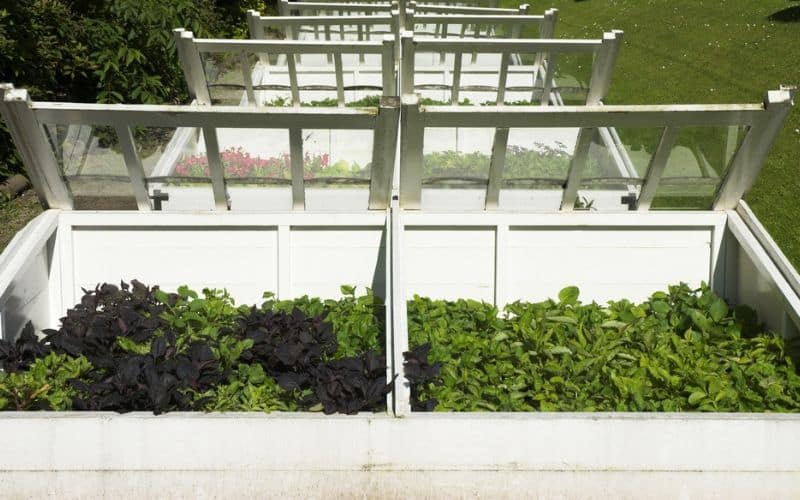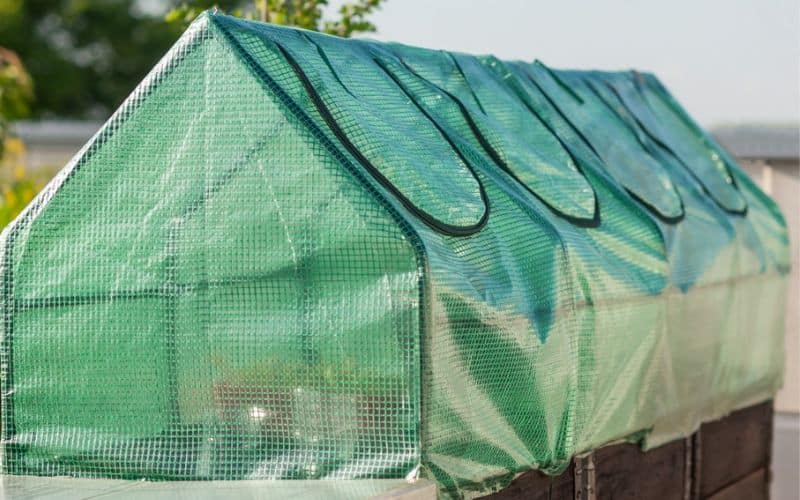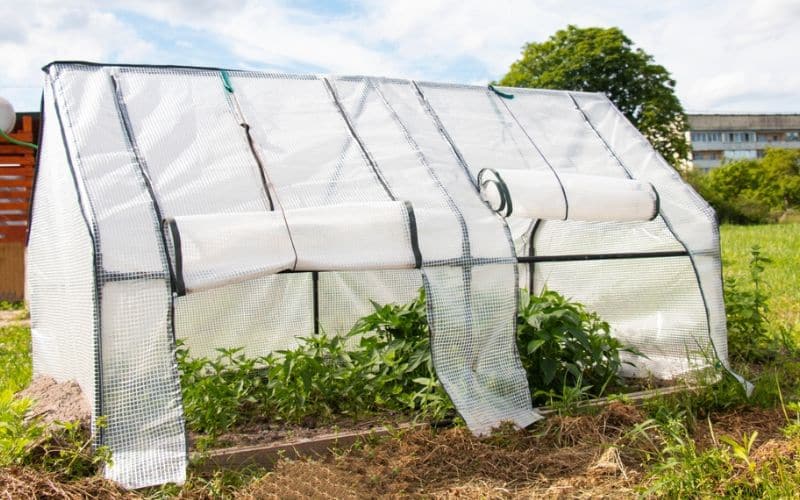
What are Cold frames and Mini Greenhouses?
Cold frames and mini greenhouses are ingenious structures designed to create controlled environments for optimal plant growth. Cold frames are simple yet effective structures consisting of a transparent top and insulated sides, offering essential protection for your plants. On the other hand, mini greenhouses are slightly larger and often enclosed, serving a similar purpose. Together, these structures go beyond traditional gardening methods, providing increased control, extended growing seasons, and weather protection.
Benefits and Advantages of Cold frames and Mini Greenhouses
Extended Growing Season: With either structure, you can embrace year-round gardening by maintaining optimal conditions for your plants. Enjoy fresh produce and flourishing greenery even during colder months.
Weather Protection: Shield your plants from the harsh elements such as heavy rain, strong winds, or unexpected temperature fluctuations. Ensure their well-being and safeguard your gardening efforts.
Controlled Environment: Take charge of the temperature, humidity, and ventilation within your structure, creating an ideal microclimate for your plants’ growth. Tailor the conditions to suit the specific needs of different plant varieties.
Versatility: Cold frames and mini greenhouses provide a versatile space for cultivating a wide array of plants. From delicate seedlings and herbs to robust vegetables and even small fruit-bearing plants, these structures can accommodate diverse gardening endeavors.
Types and Designs
Cold frames
Materials and Construction: cold frames typically utilize wood or metal frames, complemented by glass or polycarbonate tops. These materials offer durability and insulation to protect your plants effectively.
Size and Shape: Cold frames come in various sizes and shapes to suit different garden spaces. From small rectangular frames accommodating a few plants to larger multi-tiered structures, choose the one that best fits your needs.
Pros and Cons: Cold frames are cost-effective and relatively easy to construct. However, their smaller size may limit plant growth and require manual ventilation control.
Mini Greenhouses
Materials and Construction: Mini greenhouses predominantly feature metal or PVC frames with glass or plastic panels. These materials provide sturdiness and allow ample sunlight to reach your plants.
Size and Shape: Mini greenhouses offer more space compared to cold frames, making them suitable for larger plant collections. They come in various sizes, from small walk-ins to larger, multi-tiered designs.
Pros and Cons: Mini greenhouses provide greater capacity for plant growth, but they may require additional investments in temperature and humidity controls to maintain the ideal environment.

Setting Up a Cold Frame or Mini Greenhouse
Location Selection: Choose a spot that receives ample sunlight exposure throughout the day. Ensure easy access for maintenance and consider proper drainage to prevent waterlogging.
Ground Preparation: Before assembly, prepare the ground by leveling it and creating a suitable foundation. This can be achieved with gravel, pavers, or a concrete slab, ensuring stability for your structure.
Assembly Instructions: Follow the manufacturer’s guidelines diligently during the construction and installation process. Use the recommended tools and techniques to ensure a secure and functional setup.
Plant Selection and Care
Choosing Suitable Plants
Cold frames and mini greenhouses offer a favorable environment for a variety of plants. Seedlings, salad greens, herbs, and even small fruit-bearing plants can thrive within these structures. Choose plants that are well-suited to the controlled conditions provided.
Care Requirements
Maintain proper care for your plants within the structures. Monitor watering needs, regulate temperature and humidity levels, provide adequate ventilation, and implement effective pest management strategies.
Seasonal Planting Tips
Take advantage of the extended growing season by planning seasonal plantings within your cold frame or mini greenhouse. Consider optimal planting times for different varieties and practice crop rotation to preserve soil health.
Maintenance and Troubleshooting
Cleaning and Organization
Regularly clean and declutter your structure to maintain its functionality. Keep the space tidy, removing any debris or dead plants. Organize your gardening tools and supplies for easy access.
Common Issues
Stay vigilant for potential problems such as pests, diseases, or fluctuations in temperature. Identify and address these issues promptly to prevent any adverse effects on your plants.
Winter Preparations
Prepare your cold frame or mini greenhouse for the winter season. Insulate the structure to protect your plants from frost, add extra heat sources if necessary, and insulate exposed pipes to prevent freezing.

Tips and Best Practices
To ensure successful gardening with cold frames and mini greenhouses, consider the following tips and best practices:
Maximizing Sunlight Exposure
Position your structure strategically to capture sunlight throughout the day. Place it in an area with maximum sun exposure, orienting it towards the south if possible. Additionally, consider using reflective surfaces such as mirrors or white panels to enhance light exposure and distribution within the structure.
Improving Insulation
During colder months, it’s important to provide additional insulation to protect your plants from temperature fluctuations. One effective method is to use bubble wrap or insulation boards to line the interior walls of the structure. This extra layer of insulation helps retain heat and maintains a more stable environment for your plants.
Companion Planting
Enhance the diversity and resilience of your garden by practicing companion planting within your cold frames and mini greenhouses. Pair plants that complement each other in terms of nutrient requirements, pest resistance, or growth habits. For example, planting herbs alongside vegetables can deter pests and improve overall garden health. Research compatible plant combinations to maximize the benefits of companion planting.
Conclusion
In conclusion, cold frames and mini greenhouses are valuable assets for any gardener seeking to enhance their gardening experience. These structures provide a host of benefits, such as extending the growing seasons, protecting plants from adverse weather conditions, and creating controlled environments that support optimal plant growth.
We encourage you to embrace the possibilities that cold frames and mini greenhouses offer. By utilizing these innovative solutions, you can elevate your gardening game and unlock new possibilities for your green spaces. Experiment with different plant varieties, explore companion planting techniques, and enjoy the rewards of flourishing gardens throughout the year.
To further expand your knowledge on cold frame and mini greenhouse gardening, we recommend exploring additional resources available to you. Online forums, gardening books, and instructional videos specifically dedicated to these topics can provide valuable insights, tips, and inspiration for maximizing the potential of your cold frames and mini greenhouses.
Cold Frames and Mini Greenhouse FAQs
What is the primary difference between a cold frame and a mini greenhouse?
The primary difference is in size and structure. Cold frames have a simple design with a transparent top and insulated sides, while mini greenhouses are enclosed structures that are larger than cold frames.
Can I grow vegetables in a cold frame or mini greenhouse during winter?
Yes! Cold frames and mini greenhouses can provide a suitable environment for cold-hardy vegetables like kale, spinach, and lettuce during winter months, as long as the plants receive adequate protection from extreme cold.
How often should I ventilate my cold frame or mini greenhouse?
Ventilation depends on the weather and the needs of your plants. On warm days, open vents or windows to prevent overheating. On colder days, keep the structure well-sealed and insulated to maintain warmth inside.
Do I need a heater for my mini greenhouse in winter?
It depends on the plants you’re growing and the climate in your area. If you’re cultivating plants that need stable temperatures or if you’re experiencing severe cold, using a heater may help maintain the required temperature for healthy plant growth.
How can I maximize space in my small cold frame or mini greenhouse?
Consider using vertical growing techniques, such as trellises or hanging pots, to make better use of the limited space. Additionally, plan your planting layout to utilize every available inch, and choose dwarf or compact plant varieties that require less space.
Colin Macmillan is a seasoned entrepreneur and the CEO of Riverwood Landscape, a leading landscaping company based in Canada. He has been at the helm of the company since leaving high school, demonstrating his strong leadership skills and business acumen.
Colin’s expertise lies in various aspects of landscaping, including lawn care, interlocking, sod installation, and commercial maintenance. His hands-on approach and dedication to the craft have been instrumental in building Riverwood Landscape into a reputable brand.
One of his most notable achievements is the creation of a successful landscape franchise that services multiple locations. This accomplishment underscores his strategic thinking and ability to scale operations effectively.
Colin has also had the privilege of working with Guelph Hospital for landscaping and maintenance, a testament to the trust and reliability that his company has earned over the years.
His professional mission is to offer the best services and experiences for customers, a goal that he tirelessly pursues. Colin’s commitment to excellence and customer satisfaction continues to drive the growth and success of Riverwood Landscape.








